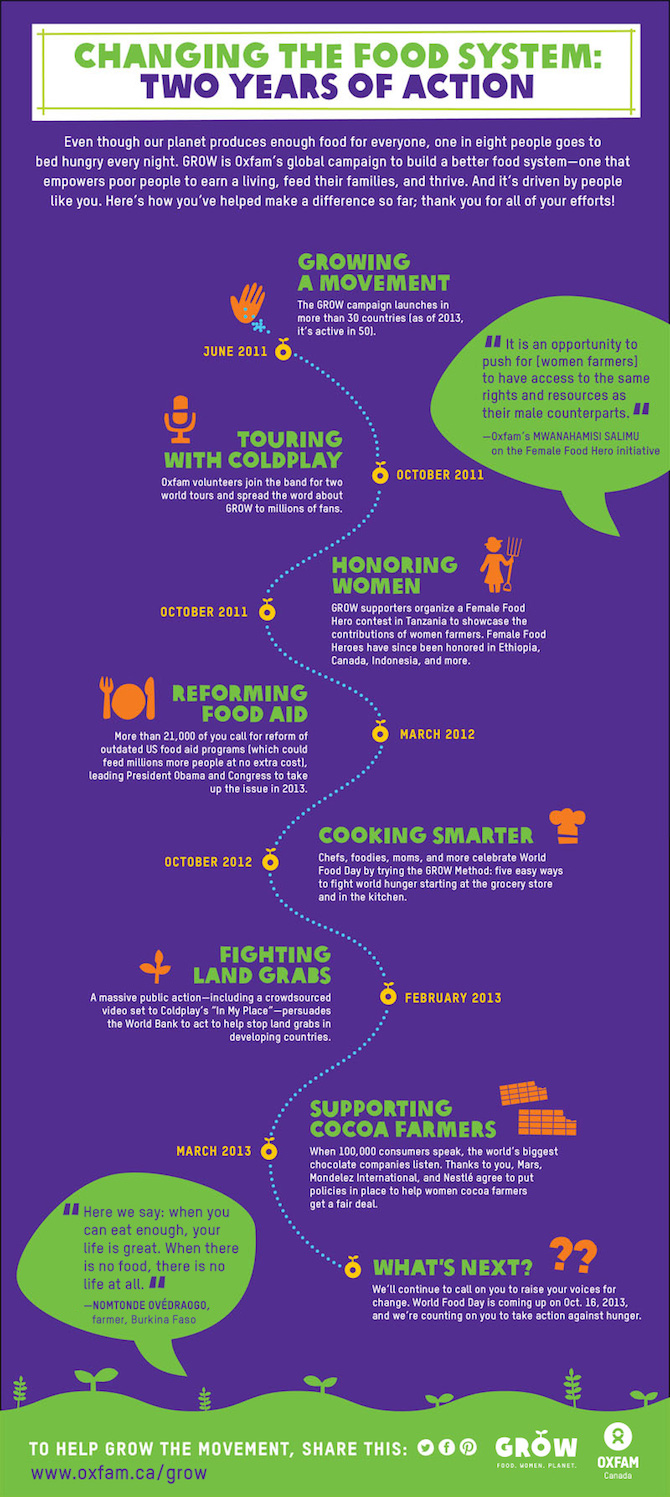Taking stock of GROW, Oxfam’s food campaign
by Simon Starling
On 1 June 2011, Oxfam launched the GROW campaign to tackle the injustice of 900 million people going to bed hungry every night. The campaign now works in more than 50 countries around the world and at the international level. We focus on 4 thematic areas key to improving people’s ability to grow and buy enough food – land rights, investment in small-scale agriculture, climate change and food prices.
Two years into the campaign, we hired an independent evaluation firm to help us take stock, review the progress we’ve made so far to properly steer the next phase of the campaign and achieve more change.
Read the full evaluation report
What have we achieved?
Oxfam staff and partners have made significant progress through a variety of campaigning tactics, including research, direct lobbying of governments, marches, petitions, using social media and coalition building. We’ve achieved commitments on food and land policies from governments, corporations, and global institutions, and increased the participation of rural women in policy processes.
- Most significantly, GROW has secured commitments by the biggest food companies in the world – Nestle, Coca-Cola and others – to change their policies on the social and environmental impact of their operations.
- A second highlight was the astounding public participation in the campaign – a “Stop the African Hunger Games” petition on the Sahel food crisis in 2012 led to 533,000 signatures; nearly 400,000 people have taken action on food companies, and 30,000 have tried the ‘GROW method’ to see how they can feed their families in a way that contributes to a fairer world. Another 107,000 people successfully petitioned the government of Guatemala to return land to people previously forcibly evicted from their homes.
- Finally, with the help of Coldplay and 50,000 supporters, GROW secured the commitment of the World Bank to improve its policies on investments in land in developing countries, setting an important example to all investors that could help put a stop to land-related human rights abuses and prevent greater poverty, hunger and hardship.
For more on the GROW campaign achievements and lessons, see the evaluation report.
What have we learned?
Some of the lessons we’ve learned include the need to avoid rapid shifts from one theme to another and allow sufficient time for an appropriate adoption by audiences and to achieve change. Whilst our campaigns in developing countries will continue to be given the greatest chance of success by adapting their work to their local contexts, we also need to do better at capitalizing upon achievements at the local level and highlight, support and replicate our success ‘globally’.
Oxfam wants to engage millions of people in the campaign. So we’ll also be looking at ways that social media can extend our reach dramatically. We intend to foster people to people connections with the ‘heroes’ who are tackling injustice every day. And we’ll continue to push the boundaries on publicizing land grabs, tackling climate change, and pushing for women’s rights.
Be part of the team!
Thank you for taking a stand with us as the GROW campaign strives to help people fight the injustice of hunger. We are at a critical time in the fight to guarantee people’s access to food, and the land to grow it on, as the increasing impact of climate change on food becomes clearer.
The next two years will see the United Nations finalizing its post-2015 development strategy and global negotiations for a crucial global climate change agreement, both of which will have direct impact on agriculture and people’s food security. Join us and take action in the GROW campaign today!
Simon Starling is Deputy Head of the GROW Campaign, Oxfam International.
This blog originally appeared at blogs.oxfam.org


